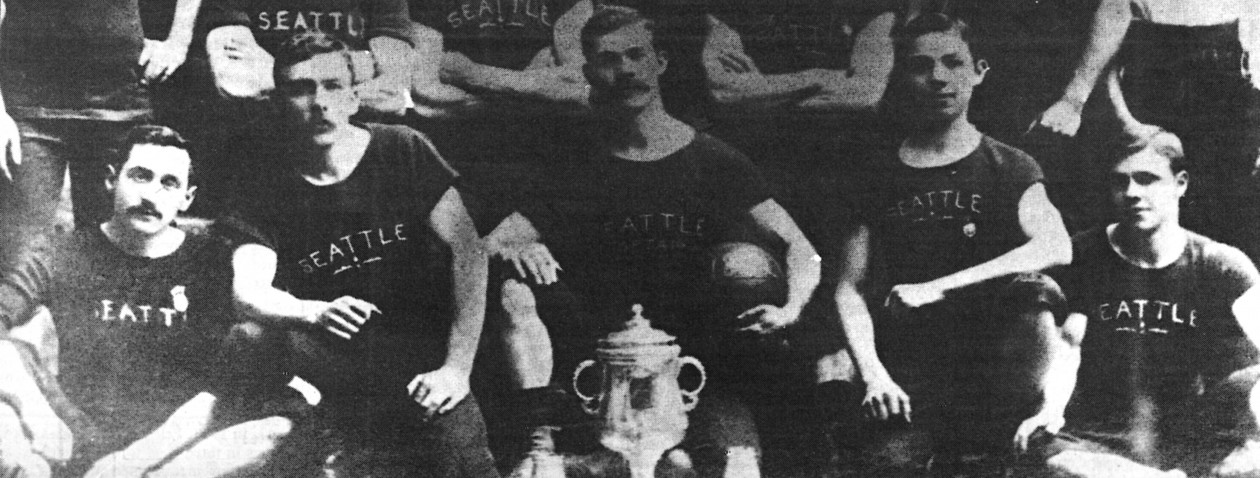Forty years ago, the best young players in America were choosing scholarship offers over signing bonuses. Whereas three years before there had been 33 clubs paying a living wage, by 1984 there were 21.
It was an Olympic year, and the United States would play before huge home crowds – upwards of 78,000 – in California during July. But by the fall, the number of professional teams would dwindle to 12 and none of them would play outdoors, 11-a-side. Instead, the fog and lasers and thumping soundtrack of Major Indoor Soccer League showmanship ruled the day.
“Back then, soccer was imploding all over the United States,” former Seattle Sounders coach Jimmy Gabriel said in 2007. “There was no real soccer league at that time. Everything was going in the wrong direction.”
Into this bleak landscape came a wind of change: Football Club Seattle.

One of the First FCs
Rather than sit and stew, Gabriel got busy. He and others hatched an idea to flip the script on a foreign-dominated domestic game and convinced a new convert to fund a new enterprise. In the summer of ’84, FC Seattle would go against the flow, develop their fair share of followers and, within a year, start a new league that has since morphed into the USL.
In terms of a name, FC Seattle came from the future – and the old country. It would be 21 years until FC Dallas became the MLS Burn’s rebrand, ushering in a slew of FCs and SCs. In truth, FC Seattle had been a few senior amateur teams (two men, one women’s). It also had an over-30 league entry, featuring Gabriel, the Washington Youth Soccer coaching director, and a handful of ex-Sounders, plus Cliff McCrath, then the storied coach at Seattle Pacific. Another teammate, new to the game, was Bud Greer.
The team had entered tournaments in British Columbia and faced clubs in Vancouver and Victoria that featured FC monikers. Greer, owner of Pepsi bottling plants in New York state and also a pilot, would fly several of the players to and from their playing destination. He had also been looked upon as a possible savior to the Sounders in their flagging days of the North American Soccer League. However, when Greer’s business partner unexpectedly died, he backed out. By September 1983, the Sounders folded after 10 seasons, and the NASL was reduced to nine franchises.
Going Local

Still Greer was open to investing in the sport, and Gabriel approached him with a novel concept, at least for most U.S. outposts. Instead of Americans being developed for supporting roles alongside international imports, FC Seattle’s roster would be almost exclusively comprised of local talent.
Recalled Greer in 2015, “(Jimmy) said, ‘Look, we’re seeing some pretty good players (around Washington), and it’s time we field a team of good American players.’ That was the impetus behind FC Seattle.”
It was about more than fielding a men’s team. FC Seattle would sponsor 23 youth and adult teams as well as tournaments. It also produced coaching videos and printed material.
Gabriel, the coaching director for FC Seattle, and coach Tom Jenkins already operated a senior amateur team that played both in the state premier league and U.S. Open Cup regionals. That team would be augmented by players attached to other clubs who would go through tryouts.
Gabriel, who had developed the Sounders’ reserve team program and signed several future first-team graduates like Jimmy McAlister and Mark Peterson, envisioned a broad feeder system, from youth to senior level, much like today’s Sounders development academy.
“There’s a gap between the amateur and professional levels,” he said at the time. “It’s too big of a jump from the high schools or colleges to the pros. It takes longer to adjust than the pros are allowing. We aim to fill that gap.”
FC Seattle’s inaugural roster included a mixture of current collegians (the club started as amateurs), state league stars and those seeking a second chance after their professional dreams were dashed. Among the latter was Bruce Raney, Seattle Pacific’s all-time scoring leader who was drafted by the Sounders but unable to make the final cut.
Roster Building
Of FC Seattle, Raney said, “With the pros, it was no longer fun to play. Now I’m having a good time again. The idols of my childhood, the Sounders, are gone. But FC Seattle could fill that void.”
Eddie Krueger had won a place in Gabriel’s Sounders starting lineup at the age of 19. A year later, following a coaching change, he was released. “For me, this is hopefully a steppingstone to get back into professional soccer again.”

At a Space Needle press conference, the first slate of matches was announced. It was formidable: Memorial Stadium dates with Vancouver, New York and Minnesota of the NASL – plus a sendoff friendly with the U.S. Olympic Team. To lure the latter to turf, McCrath brokered a deal to outfit the team with blazers and dress attire for the Summer Games. That totaled about $7,000.
“I can’t recall what I weighed in terms of it making a good investment,” said Greer. “I do recall thinking that we really need to keep this game in town.” For the next seven years, some of them rather bumpy, he would fund what was the only team of stature in Seattle.
For hardcore fans, it was an alternative (or addition) to the indoor game in Tacoma. For players, dreams began flickering back to life.
“Knowing that we were being given another chance with professional soccer in Seattle, FC Seattle really holds a special place in my heart,” said Rick Blubaugh, then 19.
“It was the greatest thing that happened to me at the time,” noted Tad Willoughby, a Sounders draftee out of the University of Washington. “When the Sounders and NASL were folding, it kept hope alive.”


Thank you
You’re welcome!